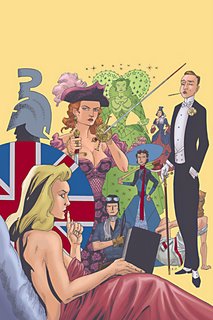 In honor of the most American of holidays, I thought I'd drop a note about the greatest British super hero team of all time. Seems that there's a new League fo Extraordinary Gentlemen heading our way from DC this fall.
In honor of the most American of holidays, I thought I'd drop a note about the greatest British super hero team of all time. Seems that there's a new League fo Extraordinary Gentlemen heading our way from DC this fall.If you've seen the horrific movie bastardization of the League, then feel free to just let that image drain right out of your brain while I take a moment or two to drop a little bit of knowledge about the true League.
Alan Moore is one of the solid pantheonic (is that a word?) comic book creators. He's rocked the DC world with The Killing Joke, crafted perhaps the best Superman stories ever in "For the Man Who Has Everything" and Whatever Happened to the Man of Tomorrow?, recrafted horror with Swamp Thing, overthrown the British government in V for Vendetta, played with convention in Supreme: Story of the Year, and crafted the finest superhero comic ever in Watchmen - and those are just the ones I've read.
The League of Extraordinary Gentlemen just might be Moore's most detailed story yet, and considering the reasearch and loving attention to detail that Moore shows in all of his projects, that's saying something. The basic set up is that the British empire - in times of need - calls together its greatest heroes (and apparently has been doing so for centuries - back to Robin Hood, Natty Bumpo, Merlin, even). The first volume of LoEG sees a team composed of Mina Harker, Alan Quatermain, Nemo, Dr. Jeckyl, and the Invisible Man. The first part of the story is the gathering of the Gentlemen from around their world where many of them have let their glory fade as Quatermain is a degenerate in an opium den, Jeckyl is terrorising the Rue Morgue, and the Invisible Man is visiting girls in a very not-for-children girls' school and convincing them of the presence - within them - of God. The depravity from which the heroes come is deep, and they do not all refrain from revisiting that depravity in the course of the two volumes of LoEG, either.
Throughout the two volumes, seemingly every possible Victorian-era hero, villian, and supernatural terror visits the league or appears in backgrounds of the scenes, suggesting that there is a much greater overlap to their stories than any author has ever before crafted. The references are so ongoing and dense that one book has been published annotating the references for each volume of the League. The books can certainly be read without the anotations, but knowing how many things you missed the first few times through - and this is dense reading, likely requiring a few tries to see so much of the richness present in even the faux advertisements that Moore and O'Neill include in the issues - makes the series that much richer.
Hopefully, DC's absolute edition of the first volume of the League will provide even more insight into the creative process that Moore and Kevin O'Neill - whose artwork brilliantly matches Moore's story - put together into both of these volumes.

No comments:
Post a Comment